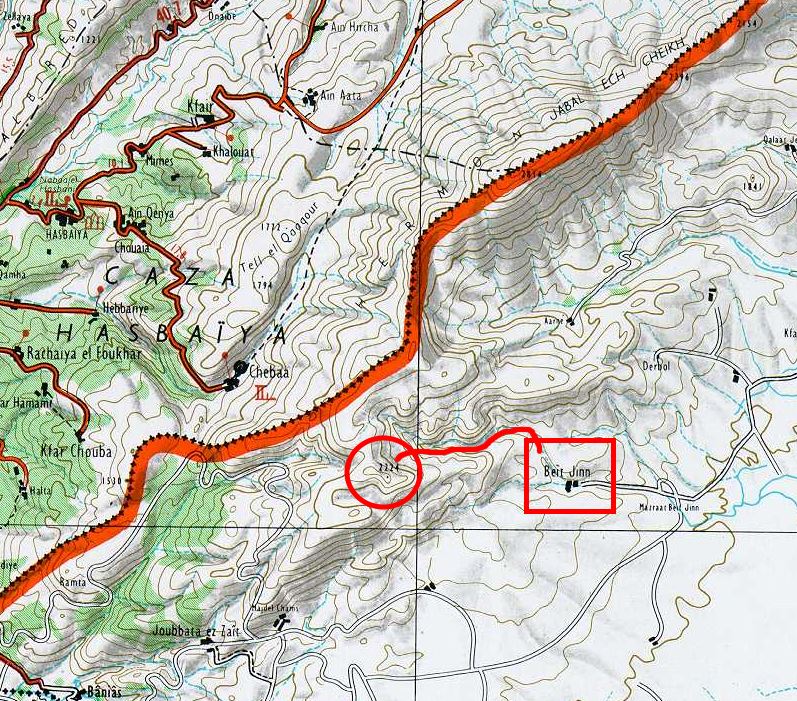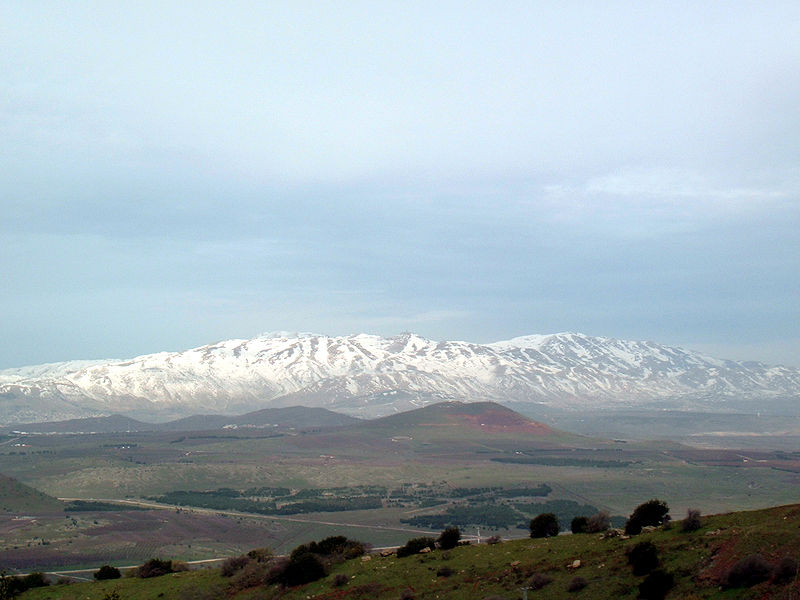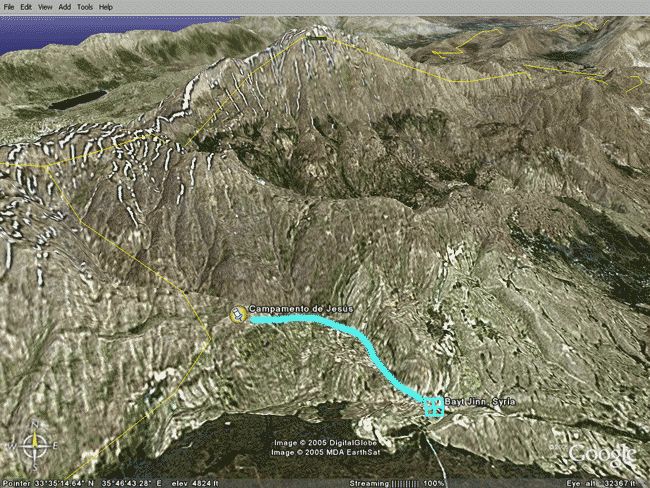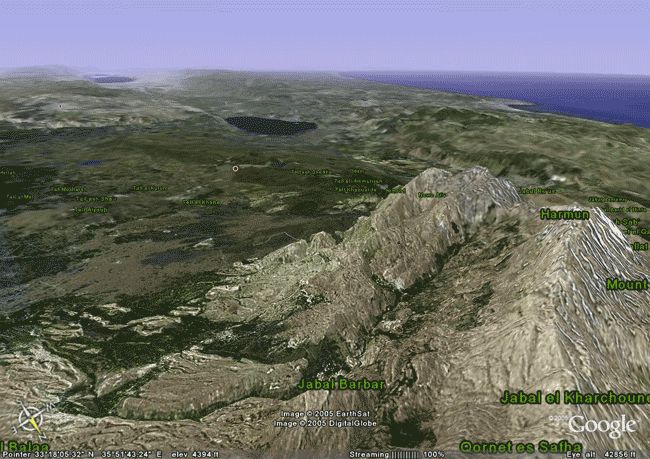© 2005 Jan Herca (license Creative Commons Attribution-ShareAlike 4.0)
With so many details that The Urantia Book offers about the place where Jesus remained in retirement for six weeks, it couldn’t be very difficult to locate the place and get a little idea of what it is like and above all, how it was.
In UB 134:8 (“The transition years”), we are told that Jesus and Tiglath built a stone deposit at a location 2,000 meters above sea level. We are also told that to get there they passed through a village then known as Beit Jenn.[1] [2]
It didn’t take me long to find Beit Jenn on a map. In a general map of Lebanon at a scale of 1:200,000 from the French National Geographic Institute,[3] the village appeared very clearly, which still exists today and is called Beït Jinn. Also, near the village there is a summit of 2,224 meters (but it is not the highest peak, which rises up to 2,814 meters). It was easy to assume that the ascension of Jesus referred to in The Urantia Book is this “small” peak. Looking at other data, I found out that in total, from Beit Jenn, which is located at 1100 meters, it was about 900 meters of ascent to the place where they built the food deposit.

It could also be seen on the map that from this 2,224-meter summit two streams descended to Beit Jenn, one of them following a gentler slope, which was the one that Jesus probably ascended.
A curious fact that emerges from all this is that all the extraordinary events that happened there took place in the territory of present-day Syria, not in Lebanon or Israel. It must be remembered that this northern border of Israel has been in permanent conflict.
The exact point was thus made a little clearer. But what was this mountain like back then?

The Hermon is actually an extensive mountain range known as Jabal Ech Cheikh with several permanent snow-capped peaks and which today has a ski resort. Due to intensive logging, the lush cedar forests have been left desolate, leaving only small areas of this fantastic tree.[4] For this reason, the photographs that some travelers have given us only show stark and lonely slopes.[5]
To get an idea of what the motley place was like in the time of Jesus, I resorted to the invaluable narration of Caballo de Troya 6, the best-seller by JJ Benítez,[6] which in its final pages reproduces this ascent in amazing detail. Such luxury of details was reused by me when writing my fictionalized version[7] of Urantia Book’s fourth part,in which I have been working for years. This way I reuse certain elements, as the asherat (a Phoenician commemorative construction historically abhorred by the Jews) and the clearing with the cedar in the center, which appear in the work of Benítez.

I thought it was a good idea for my novel[7:1] to make Jesus have a gesture of sincere worship before the asherat monument (in Caballo de Troya 6 the ascension of Jesus is not narrated, but that of Tiglat and his two companions and it is Tiglat who makes the worship gesture). This gesture of Jesus gives an indication of his personal character and contrasts with the typical Jewish attitude towards these foreign monuments (see 2 Ch 34:1-7; Mic 5:14-15). Kings and prophets of old times had fought to destroy these constructions, which were hateful to them for the simple fact that they commemorated a god other than Yahweh, the Jewish god. However, for the Jesus of my novel, the place where God is worshiped is the least important thing, the important thing is that all the constructions have been carried out by the hands of believers, regardless of their conception of God.

In my novel[7:2], Jesus tells Tiglat legends about Mount Hermon. This mount was always associated in Jewish literature with mythological stories. In the Book of Enoch, an apocryphal from the time of Jesus, we can read:
Then they all swore together and pledged themselves under anathema. There were two hundred who went down to Ardis, which is the top of Mount Hermon, which they called that because they swore on it and committed themselves under anathema. These were the names of their chiefs: Semyaza, who was their paramount chief; Urakiva, Rameel, Kokabiel, Tamiel, Ramiel, Daniel, Ezequiel, Baraquiel, Asael, Armaros, Batriel, Ananel, Zaquiel, Samsiel, Sartael, Turiel, Yomiel, and Araziel: these were his decurions. 1 Enoc 6:5-8 [8]
It is curious but this book narrates that beings come from heaven, whom the Book of Enoch calls «the Watchers», descend to Mount Hermon, where they plan their way of acting towards men. A story very similar in content to what happens to Jesus on the mountain. Perhaps Jesus chose Mount Hermon for this significance, or was it a secluded spot like any other?
¶ External links
- Original article: https://buscandoajesus.wordpress.com/descargas/
¶ References and Notes
View Beit Jenn on Google Earth: Enter “Beit Jinn, Syria” in the search box. ↩︎
National Geographic Institute of France, Lebanon. General map at 1:200,000. ↩︎
Images of a mountain, that has changed a lot today. ↩︎
The interesting journey of two enthusiastic readers of The Urantia Book. ↩︎
J.J. Benítez, Caballo de Troya 6, Editorial Planeta, 1999. ↩︎
This book is the novel “Jesus of Nazareth”, a biography about the Master based on The Urantia Book that is a work in progress by the author. ↩︎ ↩︎ ↩︎
Book of Enoch 1 or Ethiopic Enoch 6:5-8, From “The Apocrypha and Pseudepigrapha of the Old Testament” by R.H. Charles [1913] Fragments of this verse exist in the Qumran manuscript 4QEna and 4QEnb. ↩︎